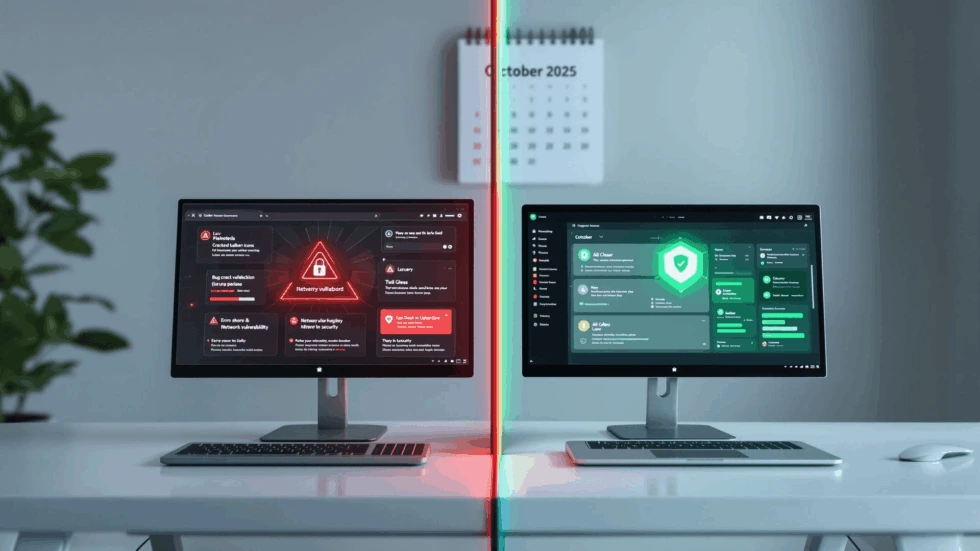Microsoft pulls the plug on Windows 10 support on October 14, 2025. If you’re like most business owners, you probably just felt your stomach drop a little. Don’t panic—but don’t ignore this either.
Here’s the reality: Your Windows 10 computers won’t suddenly stop working on October 15th. They’ll boot up, run your programs, and seem perfectly normal. But underneath that familiar interface, you’ll be operating on borrowed time.
What Actually Happens When Support Ends
Think of Microsoft support like having a security team for your building. On October 14th, that security team packs up and leaves. The doors still lock, the alarm still beeps, but nobody’s monitoring for new threats or fixing vulnerabilities when they’re discovered.
Without Microsoft’s monthly security patches, your systems become increasingly attractive targets. Cybercriminals actually catalog these “end-of-life” dates because they know unpatched systems are goldmines for exploitation. We’ve seen this play out before—when Windows 7 support ended, attacks on those systems increased significantly as hackers exploited newly discovered vulnerabilities that would never be patched.
Beyond security, you’ll start noticing the little things. That accounting software update that requires the latest Windows framework? It won’t install. The new collaboration tool your team wants? Incompatible. Your systems gradually become islands, unable to communicate effectively with the modern digital world.
The Hidden Business Impacts Nobody Talks About
Your cyber insurance coverage may be affected. Many insurers now exclude coverage for incidents involving unsupported operating systems. Running outdated software could mean claims get denied when you need coverage most.
Your compliance audits will fail. Whether it’s HIPAA, PCI-DSS, or SOC 2, every major compliance framework requires supported, patched operating systems. The penalties often dwarf the cost of upgrading.
Your employees will find workarounds. When official tools stop working, staff get creative. They’ll use personal devices, unauthorized cloud services, or sketchy third-party programs. Each workaround is a potential data breach waiting to happen.
Assessing Your Real Options
Let’s cut through Microsoft’s marketing speak and look at what actually makes sense for businesses:
Option 1: Upgrade to Windows 11 (The Ideal Path)
This isn’t as simple as clicking “update.” Windows 11 has strict hardware requirements—TPM 2.0 chips, UEFI firmware, 8th generation Intel or 2nd generation AMD processors. Many current Windows 10 machines don’t meet these requirements.
Run PC Health Check (it’s free from Microsoft) on every machine. You’ll get one of three results:
- Ready for Windows 11: Schedule upgrades starting with non-critical systems
- Needs minor fixes: Usually enabling TPM in BIOS—takes 5 minutes if you know how
- Incompatible: Time to evaluate replacement vs. extended support
Option 2: Extended Security Updates (The Stopgap)
Microsoft offers ESU for $30 per machine for the first year (or 1,000 Microsoft Reward points). Based on Microsoft’s history with Windows 7 ESU, prices typically increase substantially if extended to additional years, though second-year pricing hasn’t been announced yet.
The free ESU option requires enabling Windows Backup with OneDrive. Sounds simple until you realize the 5GB free storage fills up fast. Most businesses end up paying for additional storage anyway, negating the “free” aspect.
Option 3: Strategic Hardware Refresh (The Opportunity)
Sometimes forced change creates opportunity. Those 4-year-old desktops struggling with video calls? That server making concerning noises? This transition provides budget justification for overdue replacements.
Consider this approach:
- Replace mission-critical workstations immediately
- Move compatible machines to Windows 11
- Apply ESU to specialized systems (like those running legacy software)
- Create a 6-month replacement schedule for the rest
Option 4: Alternative Operating Systems (The Nuclear Option)
Linux is free, secure, and powerful. It’s also a completely different world that requires retraining your entire workforce and finding alternatives for every Windows-specific program you use. Unless you’re a tech company or have very specific needs, this is usually more disruptive than it’s worth.
Your Pre-October Action Plan
This Week:
- Run Windows 11 compatibility checks on all machines
- Inventory critical software and verify Windows 11 compatibility
- Back up everything (yes, everything) to at least two locations
- Document any legacy applications that might need special attention
By September 15:
- Decision made on upgrade vs. ESU vs. replacement for each machine
- Budget approved for necessary hardware or licenses
- If using ESU, registration completed (don’t wait until October 13th)
- Test Windows 11 on one non-critical system
By October 1:
- All critical systems either upgraded or protected with ESU
- Backup systems verified and tested
- Staff notified of any workflow changes
- IT support plan in place for transition issues
The Data Protection Non-Negotiable
Before you touch anything, implement the 3-2-1 backup rule:
- 3 copies of important data
- 2 different storage media types
- 1 offsite backup
Test your restore process. A backup you’ve never restored is just hope masquerading as a plan. Set a monthly reminder to verify your backups actually work—you’ll thank yourself when you need them.
Making This Transition Manageable
The businesses that navigate this smoothly share three characteristics: they start early, they make informed decisions, and they have experienced IT guidance. Whether that’s an internal IT team, a trusted MSP, or a consultant brought in specifically for this transition, expertise pays for itself in avoided downtime and prevented disasters.
Don’t let October 14th become your organization’s crisis date. The clock’s ticking, but you still have time to make this a controlled transition rather than a panicked scramble.
Need guidance on your specific situation? Reach out to our team for a complimentary 30-minute discovery call. We’ll assess your current setup and map out the most cost-effective path forward for your organization.
Remember: The goal isn’t just to survive the Windows 10 end-of-life—it’s to use this transition to position your technology infrastructure for the next five years of growth.

